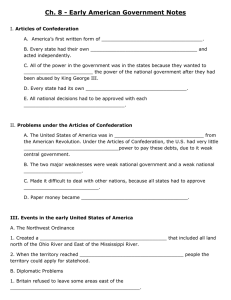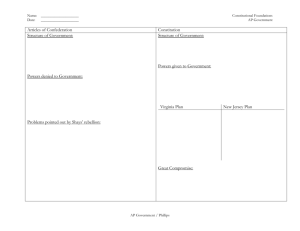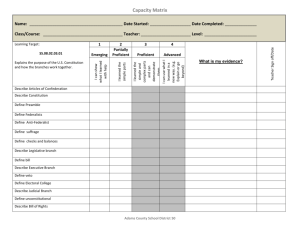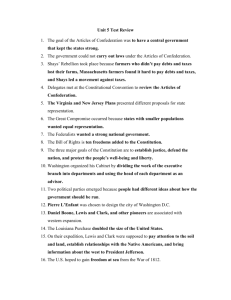Confederation to Constitution2
advertisement
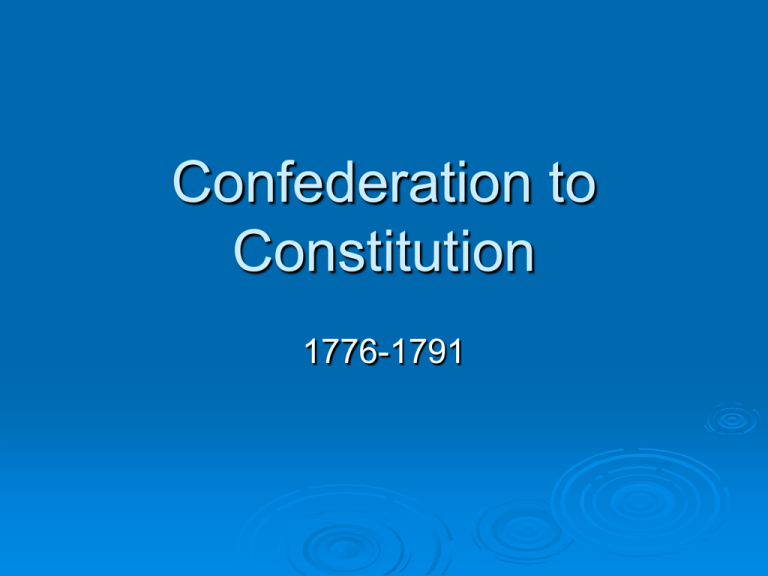
Confederation to Constitution 1776-1791 What Do You Think? What will be your main goal in creating a new government? How will you get people at the convention to agree on important issues? How do you, your friends, and families make decisions? What Do You Think? Think about meetings you have attended How were those meetings conducted? Did everyone agree on decisions made at the meeting? How did those people who presided over the meeting make sure everyone had a chance to express his or her own views on a topic? Timeline p. 203 During the 1780’s, large areas of the world were still dominated by colonial powers such as Great Britain, Spain, and France The young United States faced threats from outside powers and tensions at home over difficult issues like slavery and the role of government Do Now Take out Shay’s Rebellion homework In your notebook, answer: What was significant about Shay’s Rebellion? What recent event does it remind you of? Do Now Turn in test corrections (just the corrections not the test, hold onto the test for final exam) & Take out Articles handout from yesterday Answer in your notes: what happened with Shays’s Rebellion, why did leaders of the states want a strong national government? What are the pros and cons of a strong national government for a new United States? No homework if classwork done Given Do Now: Democratic Ideals Write down homework Why do you think the states wanted to form any national government at all? Why didn’t the states simply remain 13 independent nations? Given their experience struggling against the British, what concerns did many Americans have about forming a new national government? 13 or 1? Much of the world in the late 1700’s dominated by powerful empires Many Americans feared that each state would be too weak on its own to defend itself against foreign domination Together, states could more successfully from foreign military or economic threats Struggled to determine what form their national government should take and how powerful it should be Moving West Wilderness Road: trail into Kentucky that Daniel Boone helped build Tensions between Native Americans and settlers, 100,000 Americans live west by 1790’s Pioneers: Conquering the Wilderness (unitedstreaming) (3:12) New State Governments Wanted to take colonial governments and make them more democratic Some states experimented with different branches, others will bill of rights (modeled on English Bill of Rights (1689) All had republican form of government: people choose representatives to govern Articles of Confederation Final plan of Continental Congress was called the Articles of Confederation National government under Articles had limited powers, Americans afraid of strong government National government run by Confederation Congress, each state with one vote Articles of Confederation National government with power to wage war, make peace, sign treaties, issue money States with more power, set taxes, enforce national law Proposed to leave land west of Appalachian Mountains in control of states Articles of Confederation Continental Congress passed Articles in November 1777 All states ratified by 1781 after decided to place western lands under control of national government United States now with official government Articles of Confederation Successes: Governed nation during Revolutionary War Negotiated the Treaty of Paris Passed the Law Ordinance of 1785 Passes the Northwest Ordinance (1787) Articles of Confederation Failures: Lacked power to enforce laws Lacked power to levy taxes Lacked power to regulate trade among the states Required all thirteen states to approve changes to the Articles Articles of Confederation States National Gov’t Set Taxes Wage war Enforce laws Make peace Control western lands Have one vote in Congress Sign treaties Issue Money Articles of Confederation United Streaming videos Northwest Ordinance Critical question of how to deal with western lands Land Ordinance of 1785 called for surveyors to stake out six mile square plots called townships in Western lands These lands became known as the Northwest Territory Northwest Territory became states of Ohio, Indiana, Michigan, Illinois, Wisconsin, and part of Minnesota Northwest Ordinance (1787) When a territory had 5,000 free males in an area, men who owned at least 50 acres could elect an assembly When there were 60,000 people, they could apply to become a new state Stated that in Northwest Territory: slavery outlawed, rivers open to navigation by all, freedom of religion and trial by jury guaranteed set the pattern for orderly growth of the U.S. Northwest Ordinance United Streaming: Confed to Constitution: To The Mississippi: Westward Expansion and the Northwest Ordinance of 1787 (02:39) Northwest Ordinance game http://athena.esu16.org/~visual/projects07/ pdf/Northwest%20Ordiance%20of%20178 7.isf.pdf Weaknesses of the Articles of Confederation Debt a critical problem for the government, Congress had borrowed a lot to fight the war Much of it owed to soldiers, threaten Congress in 1783 and force them to flee Did not have the power to tax, depended on states to send money, they sent little Economy poor throughout the nation Shay’s Rebellion mid-1780’s, Massachusetts and other states faced economic problems, continued to levy high taxes Average family owed $200 in taxes a year, more than most farmers made If could not repay debt, property auctioned off, debtor jailed if money still owed Farmers asked Massachusetts legislature for debt relief, they refused In Shays’s Rebellion One leader of the rebellious farmers was a Revolutionary War veteran Daniel Shays, led a group of 1,500 men In January 1787, Shays and his men marched on a federal arsenal (a place to store weapons) 900 state militia defeated Shays’s Rebellion Shays’s Rebellion Farmers earned sympathy of many people, showed problems of working class Many are Revolutionary War veterans, now oppressed by their new government America’s leaders, typically wealthy merchant class, fear armed rebellion by “common man” Some leaders realized that a stronger national government was needed, both to raise more money and defend its interests Thomas Jefferson Author of the Declaration of Independence, unlike other leaders, not alarmed by Shays’s Rebellion “I hold it that a little rebellion now and then is a good thing… the of liberty must be refreshed from time to time with the blood of patriots and tyrants. It is its natural manure.” Shay’s Rebellion Howard Zinn, People’s History Punishing the Rebels Sentences of Shays and his followers controversial After about a dozen rebels sentenced to death, sheriff of Pittsfield found a note on his door “he that condemns and he that executes shall share alike” Two of the rebels hanged for looting, all others including Shays pardoned Articles of Confederation United Streaming: Confed to Constitution America After the Revolution: The Roots of Democracy (00:52) The Articles of Confederation: 1781-1788 (01:26) Do Now Take out 8.2 hw for me to check Write down tonight’s hw Class: go over hw, Shays, notes, activity In your notes, answer: How were checks and balances designed to limit the power of government? How does this relate to branches of government (executive, legislative, and judicial)? 1. Which state would have the greatest interest in having slaves counted as part of their population for purposes of representation? 2. Why did the North and the South have differing opinions on whether or not slaves should be counted as part of a slave’s population? Comparing Plans for Gov’t Virginia Plan New Jersey Plan Legislative Branch Two (branches): representation determined by state population or wealth Lower House: elected by the people Upper House: elected by lower house One house: one vote for each state, regardless of size Elected by state legislatures Executive Branch Appointed by Legislature Appointed by Legislature Judicial Branch Appointed by Legislature Appointed by Executive Which plan appealed more to smaller states? 8.2 HW Constitutional Convention: meeting in Philadelphia of 55 delegates with the goal of creating a new national government Founders: along with other leaders, delegates called Founders or Founding Fathers (Thomas Jefferson, John Adams not present) James Madison: took detailed notes, contributed greatly to the Constitution, promoted the Virginia Plan, strong government, “Father of the Constitution” 8.2 HW Legislative branch: branch of government that would create laws (House of Representatives, Senate) Virginia Plan: proposal for government with three branches (executive to enforce laws, judicial to interpret laws and legislative to make laws) 8.2 HW Checks and balances: way of controlling the power of government, in certain circumstances, each branch could check the power of the other branches New Jersey Plan: single house congress in which each state had an equal vote, supported by smaller states 8.2 HW Great Compromise: to satisfy the smaller states, each state with equal number of votes in the Senate; for larger state votes in House of Representatives based on population; three branches of government Executive branch: enforces the law Judicial branch: interprets the law 8.2 HW Three-Fifths Compromise: three-fifths of the slave population of a state would count towards representation in the legislative branch and for taxation 3. What was the relationship between the Annapolis Convention and the Constitutional Convention? Delegates to the Annapolis Convention wanted to create national trade laws, which led to the call for a national convention. 8.2 HW 4.Why did the Virginia delegates insist that the new government have three branches? They wanted a government strong enough to protect peoples’ rights, but not so strong that it would oppress the people. Each of the three branches would limit, or check, the power of the others. 5. Under the Three-Fifths Compromise, how would each state’s population be decided? By counting the total free population plus three-fifths of the slave population. Constitutional Convention In 1786, states wanted to improve trade with one another, but states placed high taxes on goods from other states Would require changing Articles of Confederation Urge for change also brought about by Shays’s Rebellion Constitutional Convention 55 delegates sent to Constitutional Convention in Philadelphia Later called Founding Fathers of U.S. Impressive group including Washington, Franklin, James Madison “an assembly of demigods”, Jefferson Did not include women, Native Americans, African Americans, or poor whites Do Now Turn in your letter or pictures on the Virginia Plan/NJ Plan/Great Compromise/ Three-Fifths Compromise (homework) Write down tonight’s hw What was the purpose of the Constitutional Convention? What was the most important decision made by this group? Independence Hall, Philadelphia Constitutional Convention Challenge: how to set up a strong, but limited federal government Washington elected president of the convention, most respected American To be able to freely debate, change minds, avoid pressured politics, sessions in secret Do Now Take out 8.3 homework In your notes, write/design a bumper sticker for either Federalists or Antifederalists while I check hw 8.3 Homework Antifederalists, federalism, Federalists, The Federalist papers, Bill of Rights 3. What arguments did the Federalists use to convince people to support the Constitution? What arguments did the Antifederalists use against them? In your own words, compare the views of the Federalists and Antifederalists. 1. Virginia Plan Legislative, executive, and judiciary parts of government Legislature with two houses: number per state to depend upon population or wealth Legislature with power to tax, regulate commerce, and make laws Supported by larger states, would give them greater representation Opposed by small states, fear domination New Jersey Plan Legislature with one house, each state with one vote Legislature with power to regulate trade and raise money by taxing foreign goods, did not offer broad powers of Virginia Plan Virginia Plan won debate Do Now Take out James Madison homework What was the Great Compromise? Why did the founders want to divide government into three branches rather than just one? Debate tomorrow (Federalists vs. Antifederalists), Review Friday for Chapter 8 test on Monday Senate: 2 per state regardless of size House: number of reps. Depends on population Great Compromise To satisfy small states, each state with equal votes in Senate To satisfy larger states, representation in House of Representatives according to population Slavery & The Constitution Southern states wanted to count slaves, Northern states argued slaves not citizens, not counted for population but for taxes Three-Fifths Compromise: 3/5 of slave population counted towards taxes on states and determining representation Fierce debate on slave trade Compromise: Congress could not ban slave trade until 1808 Slavery issue fatal weakness of founding Regulating Trade Native Americans not part of states or considered foreign countries To satisfy South, exports not taxed Few restrictions on regulating trade Activity With your group: Look over the article and answer the questions Come up with an image and way to describe your topic to the class If you finish ahead of other groups, work together on the homework Skit Write a scene in which the founding fathers are debating the Virginia Plan, New Jersey Plan, Great Compromise, and the Three-Fifths Compromise William Patterson: suggests NJ Plan; Madison the Virginia Plan; Roger Sherman of CT, the Great Compromise Ratifying the Constitution January 1788, in a church in Hartford, CT, 168 delegates meeting to decide whether or not to ratify the U.S. Constitution Controversial, issue of states rights Federalism: system of government in which power is shared between the central or federal government and the states Federalists: supported the Constitution Antifederalists Opposed to the Constitution, thought it took away too much power from states, not enough guarantees for individual rights Would president be like a king? Would senate be a powerful aristocracy? Liberties won during hard fought Revolution might be lost Federalist Papers Essays supporting federalists (Constitution) that appeared in newspapers Published together in Federalist book Written by James Madison, Alexander Hamilton, and John Jay Federalists Antifederalists More power to national gov’t, take some from states Wanted important political powers to remain with states Favored dividing powers among different branches Wanted legislative branch to have more power than executive Proposed a single person to lead executive branch Feared that a strong executive might become king or tyrant Believed a bill of rights needed to be added to Constitution to protect people’s rights AntiFederalist Arguments Too much power given to the national gov’t at expense of state gov’ts There was no bill of rights National gov’t could maintain an army during peacetime Congress, because of the “necessary and proper” clause had too much power Executive branch had too much power Federalist Arguments of gov’t into three branches protected the rights of the people Each branch represented a different aspect of the people, with all three equal, no one branch could dominate A listing of rights could be dangerous, national gov’t could violate rights not included Separation Battle for Ratification Federalists with an advantage: most of the newspapers supported the Constitution Strong opposition to ratification in Massachusetts, North Carolina, Rhode Island, New York, and Virginia If some of these states failed to ratify the Constitution, the United States might not survive Battle for Ratification By late June 1787, nine states had ratified the Constitution New York and Virginia had not yet voted Patrick Henry in Va. Fought ratification, George Mason opposed it Wanted a bill of rights, with this likely, Virginia ratified it, then NY Rhode Island the last to ratify Compare Debate your hw packet with a parnter, while I check hw Class: packet, debate prep, debate Take the next ten minutes to prepare your position with your partners Fill out the chart, prepare talking points and questions Everyone has to talk, take turns Everyone on your side will receive the same grade counts as a small quiz Bill of Rights Make a list of the rights you think the new Constitution should include (quietly on your own) Think about property, speech, religion, police, press, weapons, etc. Bill of Rights James Madison proposed a set of changes to the Constitution, edited by Congress Sent to states to ratify Ten of the amendments ratified in 1791 Ten amendments to the U.S. Constitution became known as the Bill of Rights P. 250-2 Amendment 1 Religious and Political Freedom Congress shall make no law respecting an establishment or religion or prohibiting the free exercise thereof, or abridging the freedom of speech, or of the press, or the right of the people to peaceably assemble, and to petition the Government for a redress of grievances Freedom of Religion Example Public schools School prayer Religious holidays Student religious practices Released time Teaching about religion Pledge of Allegiance & religious liberty in public schools Religious clubs Public schools & religious communities Teachers' religious liberties Bible in school Distributing religious literature Graduation ceremonies Evolution & creation Amendment 2 Right to Bear Arms A well-regulated militia, being necessary to the security of a free state, the right of the people to keep and bear arms, shall not be abridged Amendment 3 Quartering Troops No soldier shall, in time of peace, be quartered in any house, without the consent of the owner, nor in time of war, but in a manner to be prescribed by law Amendment 4 Search and Seizure The right of the people to be secure in their persons, houses, papers, and effects, against unreasonable searches and seizures, shall not be violated, and no warrants shall issue, but upon probable cause, supported by oath or affirmation and particularly describing the place to be searched, and the persons or things to be seized Amendment 5 Rights of Accused Persons No person shall be held to answer for a capital, or otherwise infamous crime unless on a presentment or indictment of a Grand Jury… nor shall any person be subject for the same offense to be twice put in jeopardy of life or limb; nor shall be compelled in any criminal case to be a witness against himself; nor be deprived of life, liberty, or property, without due process of law… Amendment 6: Right to a Speedy & Public Trial In all criminal prosecutions, the accused shall enjoy the right to a speedy and public trial, by an impartial jury of the State and district wherein the crime shall have been committed, which district shall have been previously ascertained by law, and to be informed of the nature and cause of the accusation; to be confronted with the witnesses against him; to have compulsory process for obtaining witnesses in his favor, and to have the assistance of counsel for his defense Amendment 8: Limits of Fines and Punishments Excessive bail shall not be required, nor excessive fines imposed, nor cruel and unusual punishments inflicted Examples – 8th http://law2.umkc.edu/faculty/projects/ftrials /conlaw/cruelunusual.html Amendment 10: Power of States and People The powers not delegated to the United States by the Constitution, nor prohibited by it to the States, are reserved to the States respectively, or to the people. Most court, police, education, and other powers at state level Marriage 10th Amendment Bill of Rights United Streaming: Bill of Rights Seven Principles of Government Seven main ideas or building blocks of our system of government Foundation of United States Constitution 1. Popular Sovereignty 2. Republicanism 3. Federalism 4. Separation of Powers 5. Checks and Balances 6. Limited Government 7. Individual Rights Popular Sovereignty “We the people of the United States… establish this Constitution for the United States” Source of government’s power is the people, broad range of people shared in power to govern themselves Republicanism Not the political party! People exercise political power by voting for representatives who in turn make decisions Federalism: How is Power Shared? System of government in which power is divided between a central government and smaller political units, such as states Delegated powers: given by Constitution to national government Reserved powers: powers kept by states Concurrent powers: shared by both national and state governments Powers delegated To National Gov’t Shared Concurrent Powers reserved Powers For state Gov’ts Separation of Powers: How is Power Divided? Founding fathers concerned that too much power might fall into hands of one group Division of government into branches No one power is given all the power Legislative Branch: makes laws Executive Branch: President enforces the law Judicial Branch: Supreme Court interprets the law Checks and Balances: How is Power Evenly Distributed? Each branch of government can exercise checks or controls over other branches Branches are separate but depend on each other to perform work of government Congress makes laws; President can veto law; Supreme Court can declare law passed by Congress and signed by president as against the Constitution Limited Government: How is Abuse of Power Prevented? Power of government restricted Everyone must obey the law, rich, powerful, those in government Article 1 Section 9 of the Constitution lists powers denied to Congress Article 1 Section 10 forbids states to take certain actions Individual Rights: How are personal freedoms protected? Bill of Rights guarantees certain individual rights Later amendments also advanced cause of individual rights

